A Zero Trust Approach to Data Transfer
Building Zero Trust Architecture to Reinforce the Security of your File Transfer

A Zero Trust Approach to Data Transfer

Developing A Zero Trust Transfer Strategy
What is Zero Trust?
Zero Trust is an approach in which any user, device, system, or network inside or outside of the security perimeter is not to be trusted and that every attempt at access is high risk. Rather than assuming safety once inside a firewall, Zero Trust works on the principle of “never trust, always verify.”
It is a framework that assumes a breach will happen, or has already occurred, and that bad actors may already be inside your network – thereby forcing organisations to lock down, segment and secure their data infrastructure. By doing so, Zero Trust reduces the attack surface, limits lateral movement, and provides stronger resilience against modern cyber threats.


What is Zero Trust?
Zero Trust is an approach in which any user, device, system, or network inside or outside of the security perimeter is not to be trusted and that every attempt at access is high risk. Rather than assuming safety once inside a firewall, Zero Trust works on the principle of “never trust, always verify.”
It is a framework that assumes a breach will happen, or has already occurred, and that bad actors may already be inside your network – thereby forcing organisations to lock down, segment and secure their data infrastructure. By doing so, Zero Trust reduces the attack surface, limits lateral movement, and provides stronger resilience against modern cyber threats.

Why is Zero Trust Important for Your Data Transfers?
Data is one of your most valuable assets, but also one of the most targeted. Every time information moves between systems, users, or third-party services, it creates potential entry points for attackers. Traditional security models, which assume that anything inside the network is safe no longer matches the reality of cloud-first, hybrid, and remote-working environments.
By applying Zero Trust principles to data transfers, organisations reduce the likelihood of breaches, protect sensitive information from being exposed, and maintain compliance with increasingly strict data protection regulations.
How This Whitepaper Will Help
Our whitepaper 'A Zero Trust Approach to Data Transfer' outlines the key actions you can take to move towards a Zero Trust posture for your data transfer infrastructure, by leveraging a secure managed file transfer tool.
Whether you’re beginning your Zero Trust journey or looking to strengthen existing processes, this whitepaper equips you with the insights and tools needed to ensure your data moves safely - protecting your business, your partners, and your customers.


How This Whitepaper Will Help
Our whitepaper 'A Zero Trust Approach to Data Transfer' outlines the key actions you can take to move towards a Zero Trust posture for your data transfer infrastructure, by leveraging a secure managed file transfer tool.
Whether you’re beginning your Zero Trust journey or looking to strengthen existing processes, this whitepaper equips you with the insights and tools needed to ensure your data moves safely - protecting your business, your partners, and your customers.
Download the Zero Trust Data Transfer Whitepaper
What's Included in this Whitepaper?
This whitepaper provides clear, straightforward explanations to help you understand the principles of Zero Trust and how to apply them to your secure data transfer strategy. Inside, you’ll find:
Best practices for setting up your solution with Zero Trust principles
Practical guidance on strengthening your file transfer solution
Common security
pitfalls and actionable tips for reducing risk
Common use cases explaining how different industries use MFT
What to consider when planning your deployment and the models available
Access to downloadable resources for next stages

About the Author
Richard Auger is Pro2col’s Principal Technical Consultant, bringing over two decades of expertise in file transfer, middleware, and integration technologies. Throughout his career, he’s designed, implemented, and optimised secure, scalable solutions for organisations across all sectors, including finance, healthcare, logistics, and government, on a global scale.
Known for his deep technical insight and practical, solution-focused approach, Richard is a trusted advisor to enterprises seeking to modernise and future-proof their data transfer infrastructure.
Guides and Resources
Secure Your File Transfers with Confidence
Pro2col helps organisations implement secure, efficient, and compliant data transfer solutions. Our Managed File Transfer Consultancy supports businesses across every industries, including healthcare, retail, logistics, government, and more.
Frequently Asked Questions
The Zero Trust framework is built on the concept that no user, device, or system should be trusted by default, whether inside or outside the network.
Its core principles include continuous authentication and authorisation, enforcing least-privilege access, segmenting networks and data, monitoring activity in real time, and detecting anomalies proactively. By implementing these principles, organisations reduce the risk of unauthorised access, limit the potential impact of security breaches, and gain full visibility into how users and systems interact with critical data.
Implementing a Zero Trust approach helps enterprises keep their data safe by making sure every access and transfer is verified - no matter where it’s coming from. This means sensitive data is protected, breaches are harder to pull off, and attackers can’t move freely inside a network.
It also makes staying compliant with regulations easier. By tracking and controlling who accesses what data and when, companies can respond quickly to audits and demonstrate strong security practices.
On top of that, Zero Trust reduces risks from insider threats by giving people access only to the data they actually need. It works well for modern work setups too, like remote teams or cloud-based systems, while simplifying monitoring and incident response. In short, it helps companies stay secure, compliant, and flexible all at once.
In highly regulated sectors like healthcare and finance, where compliance with HIPAA, GDPR, and PCI DSS require strict data handling and auditing, a Zero Trust framework provides detailed visibility into who accessed what data, when, and from which device. This helps organisations demonstrate compliance during audits and reduces the risk of costly violations.
While healthcare and finance are obvious examples, Zero Trust benefits every industry that handles sensitive data. Retail, government, transport, utilities, and even entertainment organisations can leverage it to meet regulatory standards, protect customer information, and ensure secure, auditable data transfers across their systems.
Yes, a Zero Trust framework can be applied to both cloud-based and on-premises managed file transfer (MFT) solutions. The core idea is the same in both cases: verify every user, device, and action before granting access to any file.
No matter the environment, organisations can secure hybrid workflows, maintain consistent policies, and get full visibility over all file transfers without slowing down business operations. It ensures that sensitive data is protected, whether it’s stored locally or in the cloud.
Yes, Pro2col can help your organisation implement a Zero Trust approach to secure file transfers. As a specialist consultancy, with over two decades of experience in data transfer and security, Pro2col guides enterprises through every stage of adopting Zero Trust principles.
This includes assessing current file transfer processes to identify vulnerabilities, designing a roadmap for implementation, and selecting or configuring managed file transfer (MFT) solutions that enforce strict authentication, encryption, and access controls. Beyond technical implementation, Pro2col provides training, certification, and professional services to help organisations maintain a robust Zero Trust environment.
Getting started is easy. Using our Enterprise Maturity Model for MFT, you can quickly assess your organisation’s current position and identify areas for improvement. To speak to one of our experts about how Pro2col can help secure your data transfers today, get in touch with our team.






